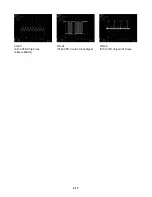
1-4
SERVICING PRECAUTIONS
CAUTION : Before servicing the STB covered by this service
data and its supplements and addends, read and follow the
SAFETY PRECAUTIONS. NOTE
: if unforeseen circum-
stances create conflict between the following servicing pre-
cautions and any of the safety precautions in this publica-
tions, always follow the safety precautions.
Remembers Safety First:
General Servicing Precautions
1. Always unplug the STB AC power cord from the AC
power source before:
(1) Removing or reinstalling any component, circuit board,
module, or any other assembly.
(2) Disconnection or reconnecting any internal electrical
plug or other electrical connection.
(3) Connecting a test substitute in parallel with an elec-
trolytic capacitor.
Caution
: A wrong part substitution or incorrect
polarity installation of electrolytic capacitors may result
in an explosion hazard.
2. Do not spray chemicals on or near this STB or any of its
assemblies.
3. Unless specified otherwise in this service data, clean
electrical contacts by applying an appropriate contact
cleaning solution to the contacts with a pipe cleaner,
cotton-tipped swab, or comparable soft applicator.
Unless specified otherwise in this service data, lubrication
of contacts is not required.
4. Do not defeat any plug/socket B+ voltage interlocks with
whitch instruments covered by this service manual might
be equipped.
5. Do not apply AC power to this STB and/or any of its elec-
trical assemblies unless all solid-state device heat sinks
are cerrectly installed.
6. Always connect test instrument ground lead to the
appropriate ground before connection the test instrument
positive lead. Always remove the test instrument ground
lead last.
Insulation Checking Procedure
Disconnect the attachment plug from the AC outlet and turn
the power on. Connect an insulation resistance meter(500V)
to the blades of the attachment plug. The insulation resis-
tance between each blade of the attachment plug and acces-
sible conductive parts (Note 1) should be more than 1M-
ohm.
Note 1 :
Accessible Conductive Parts including Metal pan-
els, Input terminals, Earphone jacks, etc.
Electrostatically Sensitive (ES) Devices
Some semiconductor (solid state) devices can be damaged
easily by static electricity. Such components commonly are
called Electrostatically Sensitive (ES) Devices. Examples of
typical ES devices are integrated circuits and some field
effect transistors and semiconductor chip components.
The following techniques should be used to help reduce the
incidence of component damage caused by static electricity.
1. Immediately before handling any semiconductor compo-
nent or semiconductor-equipped assembly, drain off any
electrostatic charge on your body by touching a known
earth ground. Alternatively, obtain and wear a commer-
cially available discharging wrist strap device, which
should be removed for potential shock reasons prior to
applying power to the unit under test.
2. After removing an electrical assembly equipped with ES
devices, place the assembly on a conductive surface such
as aluminum foil, to prevent electrostatic charge buildup or
exposure of the assembly.
3. Use only a grouned-tip soldering iron to solder or unsolder
ES devices.
4. Use only an anti-static solder removal device. Some
solder removal devices not classified a “anti-static” can
generate electrical charges sufficient to damage ES
devices.
5. Do not use freon-propelled chemicals. These can
generate electrical charge sufficient to damage ES
devices.
6. Do not remove a replacement ES device from its protec
tive package until immediately before you are ready to
install it. (Most replacement ES devices are packaged with
leads electrically shorted together by conductive foam,
aluminum foil, or comparable conductive material).
7. Immediately before removing the protective material from
the leads of a replacement ES device, touch the protective
material to the chassis or circuit assembly into which the
device will be installed.
Caution : Be sure no power is applied to the chassis or
circuit, and observe all other safety precautions.
8. Minimize bodily motions when handling unpackaged
replacement ES devices. (Normally harmless motion such
as the brushing together of your clothes fabric or the lifting
of your foot from a carpeted floor can generate static elec-
tricity sufficient to damage an ES device.)
Содержание HD-SAT520
Страница 8: ...3 8 Fig 01 Fig 02 Fig 03 Fig 04 Fig 05 Fig 06 Fig 07 Fig 08...
Страница 14: ...3 14 Fig 12 Fig 13...
Страница 39: ...3 39 FIG 01 FIG 02 FIG 03 FIG 04 FIG 05...
Страница 105: ...3 68 3 69 2 FRONT CIRCUIT DIAGRAM...
Страница 106: ...3 70 3 71 3 CPU 1 CIRCUIT DIAGRAM...
Страница 107: ...3 72 3 73 4 CPU 2 CIRCUIT DIAGRAM...
Страница 108: ...3 74 3 75 5 TERRESTRIAL CIRCUIT DIAGRAM...
Страница 109: ...3 76 3 77 6 DVI TRANSMITTER NTSC ENCODER CIRCUIT DIAGRAM...
Страница 110: ...3 78 3 79 7 ATSC TP DEMUX VD XDO CIRCUIT DIAGRAM...
Страница 111: ...3 80 3 81 8 VDP I F DISPLAY CIRCUIT DIAGRAM...
Страница 112: ...3 82 3 83 9 AUDIO DECODER SPDIF CIRCUIT DIAGRAM...
Страница 113: ...3 84 3 85 10 NTSC AUDIO PROCESSOR CIRCUIT DIAGRAM...
Страница 114: ...3 86 3 87 11 POWER DSS FRONT CIRCUIT DIAGRAM...
Страница 115: ...3 88 3 89 12 DIRECTV TP DEMUX CIRCUIT DIAGRAM...
Страница 116: ...3 90 3 91 13 SMART CARD I F CIRCUIT DIAGRAM 1...
Страница 117: ...3 92 3 93 14 SMART CARD I F CIRCUIT DIAGRAM 2...
Страница 118: ...3 94 3 95 PRINTED CIRCUIT DIAGRAMS 1 DIGITAL MAIN P C BOARD BOTTOM...
Страница 119: ...3 96 3 97 2 DIGITAL MAIN P C BOARD TOP...
Страница 120: ...3 98 3 99 3 POWER P C BOARD 4 KEY P C BOARD 5 KEY P C BOARD LOCATION GUIDE...
























